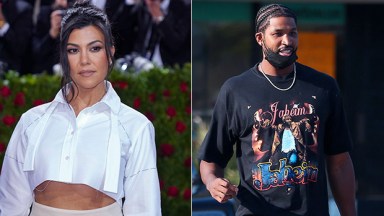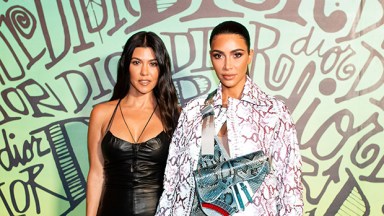Inside of mins of greeting me at his 1st Earl Baldwin of Bewdley Hills studio, artist Max Hooper Schneider summed himself up as “Mr. Paradox.”
The quip got here according to the desk he’d laid out with each inexperienced juice and brownies, but it surely applies to lovely a lot the entirety he’s were given cooking within the rooms past, works in walk and fabrics in numerous states of exchange and rot: a copper-plated orange, its desiccated remainder damn throughout the nubbed shell; a helicopter’s wrecked carcass suspended from the ceiling, dangling a scatter of fluorescent tube god rays; a desk unfold with antique neon signage fragments, like a leak of discovered poetry; a hundred-dollar heap of McDonald’s French fries, 5 months used and counting.
“I think of the studio as a gut,” says Hooper Schneider, “and I’m like a digestive enzyme, circulating through it.”

A feature of melted collectible figurines from the “Route 666” piece through Hooper Schneider.
(Gary Coronado / Los Angeles Instances)
A devoted runner who says the game leaves him continuously hungry, Hooper Schneider reaches incessantly for metabolic metaphors. The viewer’s come across together with his sculptures and installations, he has written, is a dynamic alternate between our bodies “that is more akin to the mutually transformative process of eating than spectatorship.”
And now not simply usual consuming, however a charged, advanced roughly feasting. Sensory gluttony that yieldings opaque nourishment for the thoughts.
“Falling Angels,” an in depth display of the L.A.-based artist’s contemporary experiments in biome shatter and regeneration, opens Might 6 at François Ghebaly. The rooms of the downtown gallery can be overclouded, and Hooper Schneider’s “disorienting vistas,” microcosmic eventualities that allude to macrocosmic phenomena of ecological, organic, anthropological and sociological misery, can be illuminated dramatically inside of.
“We do live in an age of crisis,” he says. “We’re living in the lethal effects of centuries of wanton destruction. My work looks at the crises, but it does seduce. It’s an intoxicant. Maximalism, horror, tragedy — I traffic in those, but only as tools to access things that are radically hopeful and joyous and exuberant.”
A bunch of tabletop vitrines within the display do business in perspectives of odd, sculpted, subaquatic splendor — brightness cast-glass mushrooms, sea anemones, dazzling ribbons of kelp. The works advanced according to the artist’s revel in of deep-sea diving within the Arctic, and as a rebuttal to Renaissance notions of the elegant, which heart on nothingness and dying.

A work from Hooper Schneider’s “Diving Bells” form.
(Gary Coronado / Los Angeles Instances)
“Nothing is desolate,” he explains. “If you look hard enough, and think through the normal binaries of life, there’s a lushness to everything. Everything is a swarm of bodies teeming and festering and breaking down and regrowing.”
The vitrines themselves are distillations, and the cut-out portholes that serve a view within are an extra try to pay attention center of attention. Around the area of Hooper Schneider’s paintings, the miniaturization or abridge of a global (suppose dollhouses, style trains) coexists with an elaborate batch of stuff defining or filling that international. In an aquarium in his 2018 display at Jenny’s (a gallery that has since relocated to Fresh York), as an example, slight fish darted amongst their faux opposite numbers, swimming thru trash/investmrent lots of gown jewellery.
Hooper Schneider revels in recasting the common as unfamiliar, absurd, ultimate. In relation to the diving bell vitrines, “you get sucked in fast, and then suddenly, you get this mind-altering shift of scale. I don’t know what size I am. I don’t know what size I want to be anymore. And then there’s a chain reaction of seeing.”
Any other of Hooper Schneider’s pristine “speculative habitats” attracts on his youth love of dioramas. Within the immense, tabletop state, a derelict drive-in film theater is ready underneath a hillside of rhythmically laboring pumpjacks, a slope of exceedingly colourful flora, pits of ashen corpses, and palm bushes with slight human our bodies in park of fronds. The immense display performs a movie through the artist, intercut with used images accumulated through his maternal grandfather, “a flea market huckster.” Miniature displays throughout the target audience of modest junked vehicles flicker in dialog with “the parent screen.”
The scene is suffused through nostalgia, immediately worrying and likewise, he claims, “incredibly playful.” Like the broader international it mines and mimics, this international, too, manages to thrive, even supposing we don’t acknowledge its newly emergent methods of day. Right here and all over his paintings, contradictions between energy and decrepitude, nature and artifice, good looks and the gruesome don’t get to the bottom of in neutralizing cohesion, however in lieu thrum on with generative friction.
Hooper Schneider is “a force,” says gallery proprietor François Ghebaly. “He’s one of the most innovative and exciting artists working in L.A. today” — and his self-proclaimed name of Mr. Paradox suits.
“This kind of work, dealing with a critique of capitalism, has paradoxes as a starting point — the natural world versus the man-made world, the recycling of society into something else, something unknown,” Ghebaly says. “He studied science to become an artist. That in itself is a challenge to the dominant narrative.”

Hooper Schneider at his L.A. studio.
(Gary Coronado / Los Angeles Instances)
Hooper Schneider, 40, used to be born in L.A. and studied ikebana when younger, round the similar day he evolved a keenness for dying steel. His past due father used to be an equine veterinarian, and his mom, whom he reveres as “heroic, spirited, insanely brilliant,” is a retired thinker and concrete making plans theoretician who taught at UCLA.
“I’m a cross section of the clinical and the metaphysical,” he says, “and my work is the tension between them. My work is only tension, it’s only in-betweens.”
He studied biology and concrete making plans as an undergraduate at NYU, and earned a grasp’s stage in soil structure at Harvard. The trail thru various grounds gave him a talent i’m ready, he says, that facilitated his self government as a maker and a philosopher. Necessarily, he provides, “I did a ton of schooling to return to what I was doing as a kid, burning my Transformers and making new materials out of the quotidian bric-a-brac in front of me.”
Hooper Schneider has exhibited for kind of a decade, in the community and across the world, and took part within the Istanbul Biennial, the Baltic Triennial in Vilnius, Lithuania, and two times within the Land Artwork Mongolia biennial. His works are in diverse institutional collections, together with MOCA and the Hammer Museum. In 2019, for a Initiatives display on the Hammer, he grew to become the gallery right into a superior, disarming ocean-floor repository and dwelling laboratory.
“I often refer to artists as alchemists and mad scientists, but he truly is,” says separate curator and Hammer adjunct Ali Subotnick, who arranged that set up.
“He comes up with all of these weird ingredients and is constantly merging the classical sciences with being an artist. He’s confounding and full of so much energy. He really has created his own language and methodology.”

“Route 666,” through artist Max Hooper Schneider, at his studio.
(Gary Coronado / Los Angeles Instances)
In a temporary e-mail earlier than my consult with to his studio in mid-April, Hooper Schneider described his paintings for the Ghebaly display merely as “feral.” When requested to elaborate, he adopted up with a six-page “mission statement” articulating the guidelines and resources at the back of the works, bringing up Marcuse, Spinoza, Mondrian and extra. The visceral and the conceptual don’t simply meet in Hooper Schneider’s paintings — they breed earlier than our very visuals.
Listening to in regards to the exhibition plan-cum-manifesto, Subotnick laughs with reputation.
“He uses words that go right over my head. Some of his text is impenetrable to me, but I love it and respect it. He’s full of contradictions. He’s smart and academic and knows all these big theories, but he’s also blasting heavy metal and wearing cutoff vests. Things don’t really match up, but that’s Max.”

Hooper Schneider observes a piece of his at his studio.
(Gary Coronado / Los Angeles Instances)
‘Falling Angels’
The place: François Ghebaly, 2245 E. Washington Blvd., Los Angeles
When: Tuesdays-Saturdays, 11 a.m.-6 p.m. Thru June 10.
Information: (323) 282-5187, ghebaly.com







